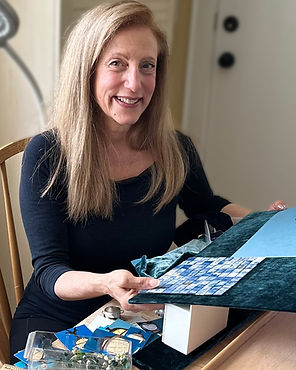
ABOUT ME
Bio
Vivian Cavalieri is a visual artist with a studio on Chincoteague Island, Virginia. Her three-dimensional miniature scenes prompt conversations on a range of global issues including immigration, climate change, and social justice. Cavalieri’s first solo exhibition took place in January-February 2025. Her second solo show is scheduled for November 2025-May 2026. Her work has appeared in numerous group exhibitions in the US and abroad. Six of her assemblages were included in WOVEN 2023, curated by Ciara Hambly of the Hambly & Hambly Gallery in Northern Ireland. Following six weeks at the Sasse Museum in Los Angeles, the exhibit travelled to France where filmmaker Lara Laigneau produced a documentary on it. In 2024, she received the Boynes Monthly Artist Award for December and was short-listed for the John Richardson French Residency Award. She was longlisted for the 2025 Visual Art Open.
Her art and art process were critiqued in “Vivian Cavalieri: Merging Personal Memory with Global Issues” at AATONAU.com (November 2024). "Between Worlds: An Interview with Vivian Cavalieri on Memory and Migration" was recently published in Insights of an Eco Artist, Voices of Dissent (August 2025). Other recent publications include Visual Arts Journal (issue 16), Collect Art, Artists Responding To… and Forget-Me-Not Press (Wretched), Modern Renaissance Magazine, and Art Seen.
Cavalieri graduated from Harvard University (BA, Fine Arts) and the New York University School of Law. She is represented by Hambly & Hambly Gallery, Northern Ireland, UK.
Artist Statement
I am a conceptual artist who creates three-dimensional mixed media assemblages that spark conversations on topics such as immigration, climate change, human-animal interactions, and social justice. While an international upbringing predisposes me to select universal topics and to incorporate references from other cultures, my palette and sense of design strongly derive from my Venetian heritage.
My works incorporate a segment of a necklace I designed into scenes crafted with dollhouse miniatures, fabrics, and other commercially manufactured items. Though these items may seem impersonal, the ones selected are symbolic, with deeply personal meanings — such as a broken replica of Richard Nixon's Oval Office chair to represent a drastic fall from grace in a work addressing second chances and a portion of my father's 1939 U.S. visa application disguised as a business license in a work addressing immigration.
Rather than criticize or preach, I invite dialogue. My detailed, small-scale scenes inspire viewers to approach. I then encourage them to engage by framing with museum glass; its clarity creates the illusion of being present at the scene. By converting assemblages into installations, I invite viewers not only to engage but to become fully immersed in the experience, even becoming participants in the work.
Whether through assemblages or installations, I aim to spark a deeper appreciation for the shared human experiences that bind us — tales of resilience and hope that transcend borders and time.

